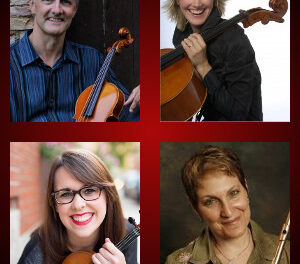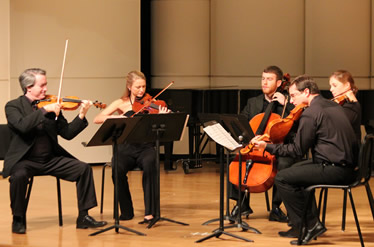The Triangle Area has never lacked for performances of the major choral settings, masses, and passions, of Johann Sebastian Bach. Many of these efforts have been associated with the Duke University Campus and Duke Chapel. However, a whole swath of the master’s works have remained unknown except to collectors of the rare recordings of all or some of his 200 or more cantatas, liturgical settings for weekly Lutheran services, along with about a dozen secular cantatas for celebrations at princely courts. The major event of the last season was a joint venture between the Choral Society of Durham and the Mallarmé Chamber Players to present historically-informed performances of Bach’s cantatas and instrumental concertos. The capacity crowd of music lovers in the First Presbyterian Church downtown created a groundswell for an annual series of concerts. The vast cantata repertoire of the composer is packed with astonishing musical treasures.
Conductor Rodney Wynkoop used the 32-voice Choral Society of Durham Chamber Choir and used three of its members served as soloists along with well-established tenor Wade Henderson. The Mallarmé Chamber Players is a flexible ensemble drawing upon the large population of free-lance and professional orchestra players throughout our region. The orchestra consisted of ten well-known local musicians using period-style instruments played according to the pitch and style of Baroque Germany.
Cantata No. 198 Laß, Fürstin, laß noch einem Strahl (Let, Princess, let yet a beam), S. 198, known as the Trauer Ode, is one of Bach’s best-known and greatest works. It was composed for the Saxon State funeral of Christiane Eberhardine, Electress of Saxony. She was widely revered for having remained true to the Lutheran faith when her husband, Augustus the Strong, converted to Catholicism in order to ascend the throne of Poland. The text was the work of the most imminent Leipzig poet J. C. Gottsched while Bach, the Kantor of Thomaskirche, scored the setting. Choir member Florence Nash’s fine program notes and John Butt’s article “Trauer Ode” in the Oxford Composer Companion: J. S. Bach have been drawn upon for commentary. Nash describes the work’s symmetry as being “split into two unequal parts by a third chorus, which falls, oddly, between the tenor’s recitative and aria.” The bass soloist is limited to only a recitative and arioso.
Unlike Duke Chapel, with its long reverberation period, the Presbyterian Church’s acoustics allow musical lines to come through clearly without interference. Clarity of musical or vocal lines was the characteristic of the performances. The German diction of both choir and soloists was excellent. Soprano Rachel Beck brought a very bright, almost instrumental quality to her recitative and aria. Alto Erica Dunkle sang with an even, firm voice with a fine, warm tone. Tenor Wade Henderson sang with the most powerful voice as might be expected of such a seasoned professional soloist. His mellow timbre was winning and his sensitive application of a wide palette of color and dynamics was welcome. Eric Campbell’s light baritone was projected well and he gave great for diction.
The opening chorus was beautifully supported by the orchestra with a pair of baroque oboes d’amore and flutes. The accompaniment of the recitative No. 4 “Der Glocken bebendes Getön” (The trembling sound of the bell) was striking. Dunkle’s voice was supported by flutes set against plucked strings. The soft sounds of the violas da gamba came to the fore in her following aria. First violinist Katharina Uhde had extensive, fine solos as part of the support for the soprano’s fast-paced aria No. 3 “Verstummt, verstummt, ihr holden Saiten” (Be silent, silent, you lovely strings!). Wynkoop chose perfectly judged tempos, allowing singers and instrumentalists enough time for articulation. Bravo! The baroque flutists were Rebecca Troxler and Yana Lowry and the baroque oboes d’amore were William Thauer and Alice Chapman.
Bach’s Brandenburg Concerto No. 6 in B-flat, S.1051, is one of only two of the set of six concertos scored for strings alone. Violins are omitted and the work’s lower pitch and somber sonority come from the combination of a pair of older established instruments, pairs of violas da gamba and violone, along with a more modern pair of violas and a cello. It has the standard three movement pattern of fast, slow, fast, baroque Italian concerto pattern. The virtuosic viola parts were taken by Suzanne Rousso and John Pruett, along with cellist Stephanie Vial. They were subtly supported by the subdued sounds of violas da gambas played by Brent Wissick and Gail Ann Schroeder and underpinned by the bass-line of the ubiquitous Robbie Link. Tempos and phrasing were excellent and the give-and-take between players was delightful. The fast-paced finale gave everyone a chance to shine.
Cantata No. 134, Ein Herr, das seinem Jesum lebend weiss (The heart that knows its living Jesus) is a parody cantata composed for Easter Tuesday in 1724. It is a reworking of an earlier secular cantata S. 134a, celebrating the birthday of Prince Leopold of Cöthen, adapted for liturgical purposes. Tenor Henderson and alto Dunkle were superb in the arias and their voices blended beautifully in their No. 4 aria “Wir danken und preisen dein brünstiges Lieben” (We thank and praise your fervent love). The striking instrumental accompaniment with its chugging quavers and its figurations is very reminiscent of the Brandenburg Concertos. The soloists, choir, and instrumentalists sang and played with remarkable clarity.
Both cantatas featured an extensive continuo ensemble consisting of William Simms, most often on the giant theorbo but occasionally taking up a lute along with lutenist player Dan Smith. Harpsichord and chamber organ duties were shared by Beverly Biggs and Jane Lynch.
Keep the Historical Bach joint concert series coming!












